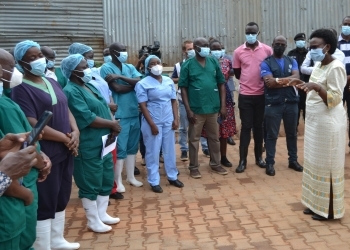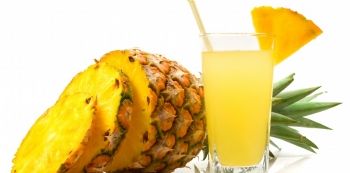
The risk for infestation from tungiasis or jiggers is high if feet are not protected by shoes and socks, either because people cannot afford them or if wearing shoes is not part of local custom, health scholars observe.
This assertion is very true in the case of sufferers in Busoga sub-region. In Nabirama Village, Butansi Sub-county, Kamuli District, Adonia Babi Kirevu and his mother, Ruth Nabirye, are both suffering from Tungiasis or jiggers, as this infection is popularly known.
His mother says, “I do not know what causes this disease but my neighbour’s children infected my children with jiggers.”
She says ever since the family was treated by the village health team and sprayed with hydrogen peroxide and jik, most members have healed, except Kirevu.
The mother of six believes this is because he has stubbornly refused to have the jiggers removed. “I try to remove the jiggers every after two days but he will not accept. So I have to sweet talk him otherwise he will run away,” Nabirye says. Nabirye’s husband, a rice farmer, abandoned them for his three other wives yet she has no steady income to fend for her big family.
How jiggers spread
Tungiasis is listed as a neglected tropical inflammatory painful itching skin disease caused by a female ecto-parasitic sand flea that burrows into the skin.
Once inside a person’s body, which is usually the feet, jiggers suck blood and grow while breeding at the same time. Once the female flea expels 100-200 eggs, the cycle of transmission begins again. Health experts say fleas require a warm-blooded host to reproduce. Intense transmission is in the dry season (dust is ideal for survival).
In addition to humans, reservoir hosts include pigs, dogs, cats, cattle, sheep, horses, mules, rats, mice, and some wild animals. They add that symptoms of this disease include; severe itching, pain, skin inflammation and swelling, desquamation of the skin, lesions and ulcerations, with black dots in the middle. If left untreated, secondary infections, such as tetanus, gangrene and bacteremia can occur. It can also lead to severe disability and death.
Most prone persons
It is estimated that more than six million people are at risk and at least 2.4 million have jiggers, 50 per cent of whom, are confined in eastern Uganda, especially the Busoga sub-region. A recent household survey in Busoga found jiggers prevalence of 40.6 per cent in schools and communities.
The distribution of tungiasis is thus patchy, and the disease occurs predominantly in impoverished populations, the head of the Jiggers Focal Point in Ministry of Health, Dr George Mukone, says, adding, “ Mortality has been reported but occurs indirectly due to opportunistic infections.”
Case studies
According to Dr Mukone, as of 2009, tungiasis was present worldwide in 88 countries with varying degrees of incidence.
He says as a result of heavy infestation, school children are unable to attend school, leading to high school absenteeism and poor academic performance.
Severely affected farmers are unable to reach their gardens leading to malnutrition and further poverty as their productivity is severely compromised. “Some people have actually gone on to lose toes and entire limbs to jiggers,” says Dr Mukone. “The traditional methods of use of unsterilised instruments such as thorns for jigger extraction puts those infected at risk of infections such as HIV/Aids and hepatitis,” Dr Mukone warns.
The single most reliable mode to stop jiggers or public health intervention is by breaking the flea breeding cycle through rendering homesteads dust-free.
This is practical during rainy seasons when rain clears dusty compounds, and house floors and verandahs are plastered repeatedly with cow dung and sand mixtures.
Local studies have shown that Benzyl Benzoate Emulsion (BBE) is quite effective in killing the embedded fleas if applied in right concentration. Another drug of proven efficacy against embedded fleas is Dimeticone, a topical application usually used to treat head lice.
In the National Master Plan for Neglected Tropical Diseases Programme 2013-2017, the Ministry of Health observes that the disease is endemic in most districts but it is intense in 20 districts of eastern region. Current efforts to control it are based on social mobilisation.
The Busoga story
The Kamuli District vector control officer, Moses Waiswa, observes that the biggest challenge facing the district’s jigger treatment drive is the non-participation of adults. “Adults with jiggers feel stigmatised and do not turn up for treatment. But the children are free to talk about their illness and come for treatment,” he says.
There are plans by the Ministry of Health to get funding to implement a comprehensive plan to eliminate this problem once and for all by not only targeting Busoga sub-region, but scaling up to other districts in the country affected by jiggers. It particularly plans to carry out case finding and treatment, environmental management and where necessary fumigation of homesteads and rehabilitation of those cases found severely disabled by the disease.
Issues at hand
Writing in the Bulletin of the World Health Organization 2009; 87:152-159, Hermann A. Feldmeier and Jorg B. Heukelbach note that Epidermal Parasitic Skin Diseases (EPSD) occur worldwide and have been known since ancient times. Despite the considerable burden caused by EPSD, this category of parasitic diseases has been widely neglected by the scientific community and health-care providers.
According to Feldmeier and Heukelbach, six EPSDs are of particular importance: scabies, pediculosis (head lice, body lice and pubic lice infestation), tungiasis (sand flea disease) and hookworm-related cutaneous larva migrans (HrCLM).
They are either prevalent in resource-poor settings or are associated with important morbidity. They add that except in epidemic circumstances, data on EPSD are not recorded so there is no reliable information on global disease occurrence, changes in incidence over time, and spatial distribution in endemic areas.
The year 2018 is targeted by the ministry for the elimination of tungiasis, but current statistics show that the country is nowhere in eliminating this scourge.
Comments (0)
📌 By commenting, you agree to follow these rules. Let’s keep HowweBiz a safe and vibrant place for music lovers!












